 |
 |
The information expressed herein should be treated as opinion. No guarantee is given or implied that any advice on the web-site is necessarily correct. Nor might it best suit other divers and clubs due to regional and personal differences. Diving is a risk sport - all advice herein should be validated with advice from your own diving club, governing body, or approved published material before being adopted.
There are several big influences in basic kit choice & configuration. Think what your style will be:
Deep means need serious air supply, redundancy is vital. If deco diving you will need at least a pony, and probably need to consider a twinset. You may also need to think about wings instead of stab. Also, a drysuit is more critical for long hangs in decompression. Instructors should have complete redundant air for all diving. (Obviously, much more than 50m depths demands tri-mix - which is a whole new ball game). If you rarely dive deeper than 30m, never decompress, are always buddied, then a single cylinder and octopus will suffice. If you also plan never to dive the northern UK or out of "season", consider a semi-dry suit. For long durations but never deep would suggest a need for Nitrox. Wildlife watchers & photographers might consider a rebreather for duration, buoyancy stability and lack of bubbles. Currently rebreathers need to have disciplined attitude though due to the new technology and recent bad press.
Even if you can afford all of your kit at once, it is better to get experience first to see what suits you as an individual and buy as you need it. Essential kit for any diving are:
|
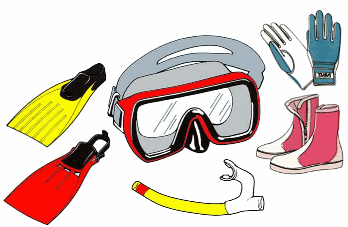 |
Other ASAP items are:
Only then worry about strobes, buzzers, lifting bags, personal flares and other more gimmicky stuff you'll never use. If money's tight, consider buying second hand at first & getting newer gear later. Loads of very safe used kit can be available (check with other club members who may be looking to upgrade).
Buy a really cheap snorkel: bent pipe with a comfortable mouthpiece as it is rarely used beyond pool training and it's easy to lose on a dive. There is a big range of fins available, some offer better propulsion than others which may be important in saving energy during dives, but most decent fins are hard to tell apart in practice. Consider light colour fins (white, yellow, pale green, light blue etc.) as these offer more visibility in poor viz for your buddy. You could also use odd coloured fins so that your buddy recognises you in a crowd. The big decision on fins is what type.
If you can afford both, get foot fins first and keep them for the pool, snorkelling or tropical diving after you've moved onto pocket fins
If dry-suited, you don't need separate boots. Remember dry-suit boots are bigger than wet boots, so if now in semi but may go to dry suit, get slightly bigger foot pocket size than needed now.
Semi-drys need neoprene wet boots to use pocket fins so the comfort and fit are most important. Zips and a strong grippy sole are very important.
Your mask must seal well and stick to face without the strap on. Get one with the maximum angle of vision sideways and up/down - compare several against points on shop wall. Check that the mask tightens and releases easily. Low air-volume clears easily and is less likely to lift off your face with buoyancy. Wide angle of view helps here too as the mask sits closer to your face. Side windows are more gimmicky than useful in practice. A good mask makes a real difference to the enjoyment of your dive. Don't scrimp, but forget flashy valves and nonsense like that. Expect to pay around £30-45.
Final tip: get a small bottle of "Divers Best" mask defogger (or similar) - it works far better than saliva, and keeps your mask clear for the whole dive which will improve both your enjoyment and safety on dives for a trivial cost.
Or not. Get real. Most new divers start off trying to co-ordinate, but most soon end up mish-mash as bits change. Go for safety not fashion. For hoods, suits & stabs get Day-Glo yellows/oranges etc for high visibility. Don't ape all-black techy diver types - they're all pose and no sense.
Think carefully here! There is a worrying trend toward novices going straight into dry-suits. This is mostly for image reasons, not common sense. Don't underestimate semi-drys. Modern ones keep you very warm and comfortable for most English diving. Dry suits do score in: post-dive warmth; comfort for multi-day trips; and adjustable insulation levels. The big downside is the extra buoyancy control to think about which can be seriously dangerous if not operated properly at all times (see " Dive safely in a drysuit").
|
Drysuits are:
|
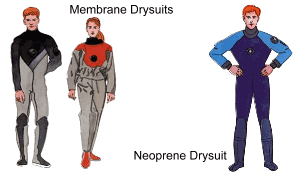 |
|
Semis are:
|
 |
So consider very carefully whether a drysuit is needed. Fair reasons for buying a drysuit are when you will be diving alot during Jan - Mar, north UK, in polluted water, or long decompression divers. If you are not sure, go for semi at first (maybe even 2nd hand), with thick waterproof coat and a good hat, for afterwards in boat. If after a season you do decide on drysuit, you won't lose much on selling a semi - or you can keep it too for liberated diving in peak season or for dives abroad. You may never need a drysuit - in which case you've saved a packet.
There are two fashionable types of BCD: Stab Jackets and Wings.
Wings give more movement and freedom at the front and you locate the centre of buoyancy nearer the centre of weight (especially with twin cylinders) - this helps reduce unwanted body roll. The downside is that it is difficult to make sure they hold your face out of the water upon surface. Also there are no pockets at the front to put other bits of kit in. It must also be easy to slip off and hand to the RIB crew else you'll be hated for making them haul in heavy kit. Can get 'conventional' design wings like stabs without pockets. Techie style ones can have steel back plates and elasticated bags that stay out of way until it's inflated, but this could be overkill for casual sport diving.
| Stabs are still a good option if a standard cylinder is used. They are better than wings at keeping your head back upon the surface as there's more buoyancy at the front. There are Two main types of stab jacket: separate bladder and single skin. A separate bladder allows for repair if it is gashed. A single skin is more likely to need junking. Otherwise it depends on your diving style. Wreckers are advised to go for abladder. If you are mostly into tropical holidays, a single skin cheaper, lighter and more compact for travel. You can also get 'soft' backpacks which can be even better for holiday packing. If you are planning on a long or rough diving career, go for high denier bladder type. The Buddy range is still very popular in the UK as a practical, indestructible, reliable and good after-sales care from AP Valves. Other big names (Mares, Scubapro, Oceanic ) can also be as robust. Thin, feeble down market ones (Seapeks et al) are only good for stop gaps, light use or pool sessions. | 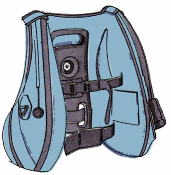 |
How to choose between a single cylinder and octopus, or main and pony set-up, or twins; and is it better having two smaller mains (one per dive) or one big one for both? As always, this choice depends on your style of diving.
|
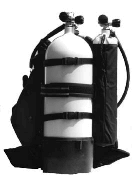 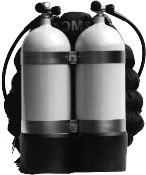 |
When choosing & fitting octopus or pony regulator, you have a choice of a left-hand hose to make it easy for your buddy to use, or right hand for use by you. In a panic situation, your buddy is more likely to just grab your 2nd stage from your mouth than go by the book; so you need an octopus/pony reg which is easy for you to cut over to. Also you can reconfigure a right hand octopus as a main regulator if need be, whereas a left-hand octopus is only any good for buddy air.
To see much practical difference in regulators you will need to be doing some serious diving. They are very simple and very reliable pieces of equipment, but it is easy to pay too much for a name, gimmicks and performance overkill. All first stages will cope with two divers sharing and breathing heavily at up to 50m (you don't need any more). The biggest risk is the 1st stage freezing rather than cutting the air supply. Environmental sealing can reduce the risk of this but it puts servicing costs up and is only a problem below 4-5 degree Celsius normally. The second stage is similar, most work very well. Some are smaller & lighter, have better ergonomics, have adjustable resistance knob, can be useful in currents or for use as octopus (better here to fit anti-free-flow valve though), but a well adjusted 2nd stage should cope with most situations anyway. To start, get a simple, no nonsense low to middle price regulator at first, then if diving starts demanding more performance you probably should be getting a pony anyway, so use the old reg for that. Don't pay extra for "Nitrox ready" regulators as they can be a sales gimmick. You can use a standard air regulator for up to 40% Nitrox anyway.
Once the size and number of cylinders has been decided (see " Choose the right air supplies"), the options include steel or aluminium, 232 bar or 300 bar, standard diameter or stumpy. Steel is generally best these days. Aluminium is corrosion free, but is much thicker walled. Perversely, this makes them heavier than good steel ones. Worse, because they are also bulkier this makes them more buoyant too. The result is that they're heavier to cart around but you still need just as much lead on your weight belt. A maximum working pressure of 232 bar is adequate for most diving needs, although you can go to 300 bar. The advantage is that you can use a smaller Water Capacity cylinder for the same volume of free air (e.g. 12.5 litre 232 bar = 2900 litres free air, but only 10 litres at 300 bar = 3000 litres free air: 100 litres more). The downside is that 300 bar 10 litre is about as heavy as a 232 bar 12.5 litre (although you can probably take a bit of lead off though). Air fills are usually more expensive to 300 bar and you will also need a high pressure 1st stage fitting which should be DIN not A-clamp international. Not a problem unless swapping between fitting types - e.g. to borrow other cylinders etc. Have to buy expensive adapters then. Also can't decant into mini-cylinder unless also getting DIN fitting on BCD (pricey option). Shorter, fatter "stumpy" or "stubby" 12 litre cylinders are popular now and are good in that they tend to be less buoyant for capacity/weight, easier to carry, more stable when stood up, less likely to pitch you face forward when floating, and fit within the length of your back to stop the valve hitting the back of your head. The downsides are that fatter cylinders cause a bit more drag in the water, and - depending where the BCD camband is fitted - sometimes high off seat-height so can't take weight off shoulders when sitting kitted for long periods. On balance though, probably more pros than cons.
My first recommendation is to find out what other club members use. Our club tends to purchase Uwatec Aladin computers so that our divers hit the same decompression penalties, etc. However, there are lots of choice and can be very dive style dependent. If money is tight and you never do deco dives, it is just about OK to go for no deco PDC (Personal Diving Computer), however it can be stressful if you ever go into deco accidentally. Though it says you have to stop and at what depth, it has no idea how long is left before you can surface safely - you just have to wait until you're told to go up (which is not nice if you're low on air too).
Generally it is much better to go for a decompression PDC even if don't intend to do deco diving. Consider too if Nitrox is on the cards within the next couple of years or so. If so, better to get Nitrox PDC now and use it at 21% O2 (air) until going on to Nitrox. If no chance, or will be three or more years at least, maybe get slightly cheaper air PDC now, then trade up to latest model later.
Air integrated has a major safety benefit; it not only warns of air consumption problems, but good ones like Uwatec Aladin also use the consumption rate to assess workload. This makes a big difference to Nitrogen uptake and thus tissue saturation for a given dive profile. A PDC increases deco obligation in this case - much less risk of DCI (DeCompression Illness). Air integrated computers are expensive though. Also there is a potential problem if the sender unit fails as you will lose the contents gauge entirely! If you always have relaxed dives and are never short of air, you will be fine without it. Just allow extra deco. If you are a regular deep deco-dive port hole chiseller, an air-integrated may be strongly recommended. If money is not a problem, nice to have a Personal Computer interface add-on too. This will let you download dive profiles and details into an electronic logbook on your PC.
Again there is a huge range of torches on the market. Small penlight style up to mega-pricey cave diver ones. It is a good idea to get a small torch early on as it makes a big difference on gloomy dives. One good example is the Underwater Kinetics Mini-Q40 - around £14. It is reasonably popular as it is small, simple, very bright beam and good battery life on alkalines (also comes with straps to allow attachment to mask strap so beam is always where your head is pointing. Beware using this can dazzle other divers when you look at them (avoid using this way on night dives). Also, can make some mask seals leak a bit. Even if you get a bigger torch later, you can still use a small torch as a backup (which is vital on night dives). Bigger torches are often rechargeable and are strongly recommended if can afford them (most are well over £100, some several hundred!).
| Disposable batteries have a shorter life. Worse, you only know for sure how long the beam will last with new batteries and may need to throw part-used batteries away to be sure of light on a long dive. Rechargeables can be topped up so always have maximum life at no extra cost. There's a high initial cost but this pays back well if you're using a torch alot. Can get non-rechargeable torch and then use rechargeable batteries. Cheaper option and better than disposables, but standard rechargeable batteries give less time than the ones with rechargeable torches. A big powerful torch makes your dives more enjoyable. Even in good light, they help see marine life under shady rocks and in any conditions, brings out their true colours. It is well worth spending money to get a good one. Make sure it's always attached to kit (even in use) as it is easy and expensive to lose. | 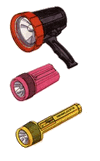 |
There are stacks of goodies and accessories you could buy. Much of it is of little real use for normal dives, so get safety related kit first. Essential accessories are of course:
Top priorities should then be:
After that, get gimmicky.
General point: accessories easily lost unless attached, so recommend using good cords/lanyards and clips for all accessories. Quik-lock clips (like the plastic bayonet clips that you get on everything now) work well and have range of methods for fitting to accessories.
Copyright © 2007 Chippenham Diving Club - BSAC1622 |
| Home Page | Site Map | Club Info | UK Diving | Club Contacts | Top Links |